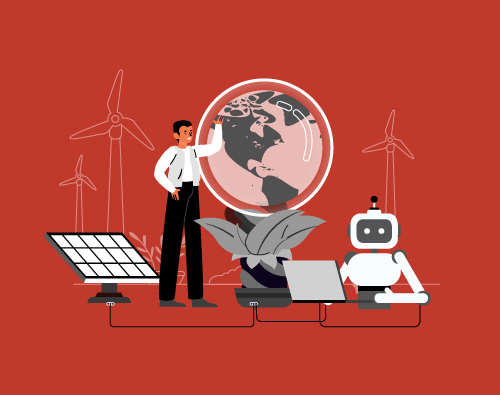Green AI: How Artificial Intelligence is Saving the Planet?


The world is facing unprecedented environmental challenges. Climate change, pollution, and resource depletion threaten our planet’s health and our very existence. In this critical time, we need innovative solutions, and that’s where Artificial Intelligence (AI) steps in as a powerful ally for sustainability.
Environmental challenges today are both expansive and interrelated. Climate change, fueled by greenhouse gas emissions, leads to heightened sea levels, severe weather patterns, and ecosystem disturbances. Additionally, pollution from plastics, industrial activities, and farming pollutes our air, water, and land. Alarmingly, we’re rapidly exhausting vital natural resources such as freshwater, forests, and marine life.
Addressing these challenges necessitates a multifaceted strategy. Harnessing the power of AI, which excels in processing extensive data sets, recognizing patterns, and forecasting trends, provides innovative solutions to address these challenges effectively.
AI is making waves in various sectors, driving progress towards a more sustainable future. Here are some exciting examples:
Beyond specific environmental challenges, AI can play a significant role in improving overall resource efficiency. AI-powered supply chain management systems can optimize logistics, reduce transportation emissions, and minimize waste. Additionally, AI can help businesses develop more sustainable products and services, considering their entire life cycle and environmental impact.
While AI holds immense potential for sustainability, it’s crucial to address some challenges:
AI is a complex field with various subfields that can be applied to environmental challenges. Here are some specific examples:
AI is not a silver bullet, but it’s a powerful tool that can accelerate progress towards a sustainable future. To maximize its impact, collaboration is key. Scientists, engineers, policymakers, businesses, and NGOs need to work together to develop and implement AI solutions that address our most pressing environmental challenges.
While AI is a game-changer, the power of individual and collective action can’t be overstated. By making eco-friendly choices daily, cutting down on our carbon footprint, and supporting green policies, we can all play a part in shaping a sustainable future.
Facing environmental challenges may seem overwhelming, but AI offers a promising solution. By utilizing AI responsibly, we can pave the way for a sustainable future. Embracing Green AI is crucial for driving positive environmental change. Now is the time to harness AI’s potential and combine it with our collective efforts to create a thriving planet for current and future generations.
Read Also:- How Artificial Intelligence is Revolutionizing Inventory Management?

The retail sector is continually changing, fueled by evolving consumer demands...
Explore more
In recent years, artificial intelligence (AI) has rapidly advanced, with neural ...
Explore more


D-23, Sector 63, Noida,
UP - 201307

141 Westgate Dr, Edison,
NJ - 08820

4 Black lion court, Mill road, Kent, UK – ME71HL

2207, 2220 Lakeshore Blvd W, Toronto ON- M8V0C1

94A Central Road, Jacanlee, Johannesburg 2194